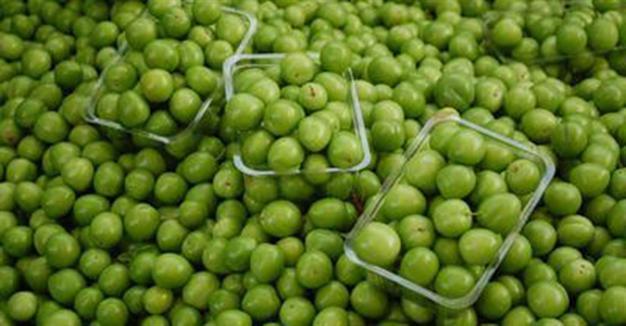Lively and lovely plum
AYLİN ÖNEY TAN - aylin.tan@hdn.com.tr
 It is an obsession. Anyone born and raised in Turkey is crazy about green unripe plums. Their appearance every year is awaited like the first snow, and when they finally show themselves at greengrocers at a hefty price, it makes the news, even the headlines in some cases. It is the ultimate manifestation of spring.
It is an obsession. Anyone born and raised in Turkey is crazy about green unripe plums. Their appearance every year is awaited like the first snow, and when they finally show themselves at greengrocers at a hefty price, it makes the news, even the headlines in some cases. It is the ultimate manifestation of spring. In a strange way, the unripe green plums mark the fragile boundary between spring and summer. Just after the arrival of green almonds in early spring, the first premature plums appear. They are usually miniscule, pale in color and not very appealing. However it does not stop fans from biting into one, often ending with the bitter experience of crushing the still fragile unripe stone. This means that spring is not yet there. When fully round, big green plums with hardened stones take the stage, it is proper spring. Alas, spring is short and ephemeral. Soon plums will start to bear a shy blush or feel slightly soft to the touch, turning into a mellow yellow in color. This is when summer has taken over. Here in Turkey, we watch over the winter-spring-summer calendar through the looking glass of a plum.
Our praised obsession is called “Can erik” in Turkish, and it is hard to translate the name to English. “Can” means life, soul or spirit, or all of them in a package, while erik is the generic name for plums. The name “Can erik” provokes liveliness, just as the feeling it evokes when you eat one, bursting with the freshness of life.
Unfortunately, there is no matching name for that, in English; it is usually translated as green gages, green plums or unripe plums. All are correct and wrong in a funny way. Even in Turkey there is confusion on varieties; a certain variety which is even bigger, greener, and juicier is named Papaz Eriği. God knows why, but it means priest’s plum. It is often confused with “can erik” and arguments on which is which is a usual puzzle. As far as I know, the saintly one is more succulent and less sour, thus really favored by fans. This special variety made it to the headlines recently, this time not as a telltale of spring, but for more awkward reasons. Some overly agitated religious fanatics have renamed the poor plum the “Imam’s Plum,” giving it an Islamic twist, eager not to give their beloved nibble to the hands of infidels. Insanely funny as it may seem, it can be regarded as a clever attempt by a foxy green grocer to increase sales, but also a sign of a change towards the climate of intolerance and the radical religious fog that inhibits sight. Let’s hope the greengage remains only the fruit of the lively, joyous spring, full of life, as its name suggests!
Bite of the week
Recipe of the Week: The Turkish perception of green gages is always on the savory side. We just dip them in salt and eat, or in cookery we add them to stews and wrapped vine leaves to add a bit of tang to the dish. But we seem to never associate them with sweets. This is my sweet innovation, a zesty greengage crumble which tastes as refreshing as fresh homemade lemonade. First, have enough greengages to fill a pie dish, about 750 g will be fine. The stones are attached to the flesh tightly so you cannot pit them; instead slice first cheeks, then the rest of the greengage as close to the stone as possible. Mix the sliced fruit with 4 tbsp sugar (or more according to the sourness of plums) and the grated rind of 1 lemon in the pie dish. As greengages are quite juicy you may prefer to toss in 1-tablespoon cornstarch to thicken the cooking juices. Now make the crumble by rubbing 100 g flour, 50 g oatmeal, 75 g butter and 75 g sugar together. Sprinkle the crumble over the plums, bake in a preheated oven at 180°C for about 40-45 minutes or until the crumble is golden. Serve not hot but lukewarm (my preference), or even cold.
Fork of the week: Özcan Turşuları, the oldest pickle shop in the Kadıköy market, is my favorite pickle spot in Istanbul. They make a wonderfully crunchy greengage pickle, the best thing next to the fresh ones. Have some today; nibble it along your happy hour martini, of course reserving the briny pickling liquid for the shaker to make the martini a dirty one. Pickle juice also works well in a G&T, provided that your tonic is an extra dry one, giving it a martiniesque edge. These pickles will surely bring zest and zing to both your drink and your life! http://www.ozcantursu.com.tr
Cork of the Week: Time to enjoy a crisp white for sunset. You may have tea with your lemony tart crumble but, if you prefer a chilled glass of white wine, my choice would be a lovely floral Muscat. Lovely new ones are now available from Turkish Misket grapes, which is the ancestor of all Muscat varieties. One exciting local one is Kavaklıdere Misket Pendore 2014, strong with bitter bergamot and lemony citrus notes backed with juicy fruit of pears with a hint of rosy lychees. What else would you need? Enjoy it even on its own; it is an ideal sip for the spring spirit.












